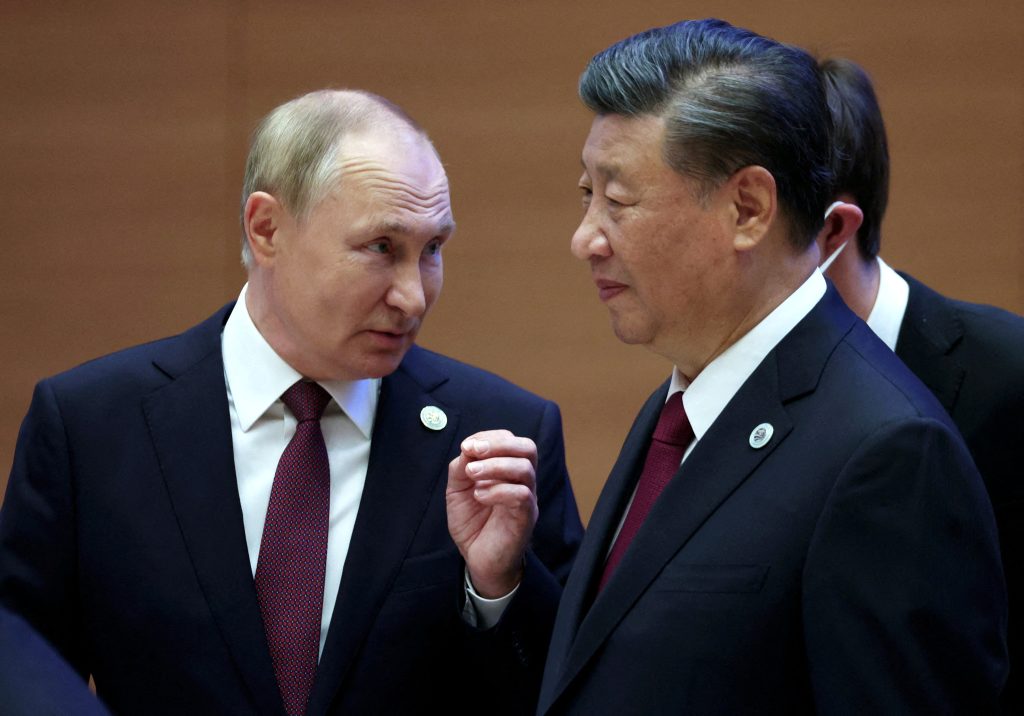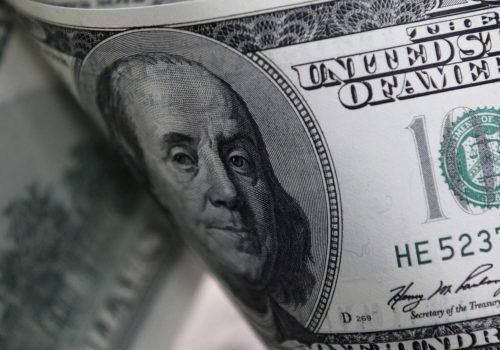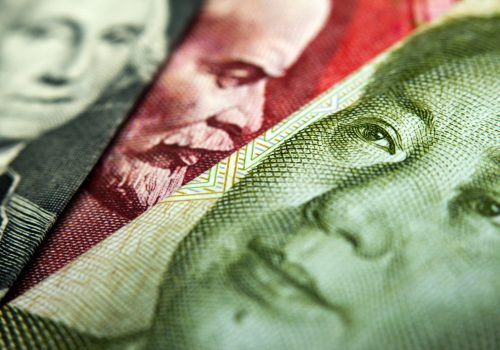Just days before Russia’s brutal invasion of Ukraine began in 2022, we warned that Russia and China’s collaboration on dedollarization—the process of reducing an economy’s reliance on the US dollar for international trade and finance—would not sanction-proof Russia’s economy. And it did not. As a result of unprecedented Western sanctions, Moscow overnight became unable to transact in dollars and euros—the world’s dominant currencies.
Russia has since pursued alternatives to manage its trade and reserves. Chinese yuan and gold became the stars of the show, but both introduced new vulnerabilities and inconveniences. Yuan makes Russia dependent on Beijing’s goodwill, while gold is not as sanctions-proof as Moscow expected, and Russia has had a hard time scaling up its illicit gold trade.
Yuanization creates new vulnerabilities
In February 2022, heavily sanctioned and isolated, Russia had to find an alternative to dollar-denominated transactions. The new currency needed two characteristics: It had to be relatively stable and minted by a non-sanctioning country. Of the few eligible options, such as the Indian rupee and South African rand, China’s yuan was the only one actively seeking an international role and able to take it on.
Moscow has rapidly intensified its use of yuan in two main ways: increasing the yuan’s share in Russia’s reserves and switching to direct ruble-yuan trade instead of using the dollar as an intermediary. At the end of last year, Russia’s Finance Ministry increased the permitted share of yuan reserves in the National Wealth Fund to 60 percent. Meanwhile, ruble-yuan trade increased eighty-fold from February to October 2022. With each of these actions, Russia created new vulnerabilities and cemented itself as the little brother in the relationship.
Ruble-yuan exchange rate vulnerability. China is Russia’s top trade partner, and its tight control of the yuan-ruble exchange rate creates risks for Russia’s balance of trade. A tightly controlled yuan may inherently seem more stable than a floating dollar, but Chinese authorities have managed the ruble-yuan exchange rate to its advantage before. Specifically, shortly after the invasion began, the Chinese government relaxed yuan controls to allow the rapidly depreciating ruble to fall faster, thus avoiding subsidizing Chinese goods for Russians by giving them more yuan than their rubles were really worth. As a result, it became much more expensive for Russia to buy Chinese goods. In other words, China could choose at any time—for political reasons or otherwise—to make Chinese imports really expensive and Russian exports to China much cheaper.
Chinese bond liquidation risk. The Russian Central Bank might not be able to sell Chinese bonds and convert the proceeds to rubles if Beijing decides to impose restrictions on yuan outflows. The liquidity risk of Chinese bonds is one of the main reasons why central banks around the world avoid purchasing them. In March 2022, the Russian Central Bank and National Wealth Fund were estimated to own 140 billion dollars’ worth of yuan-denominated assets, money that could be not be obtained by Moscow if Beijing decides to impose capital controls.
Currency swap lines elimination risk. Russia is vulnerable to Beijing’s political will when it comes to currency swap lines—an agreement between two central banks to exchange currencies. Moscow has used bilateral swap lines with the Chinese Central Bank to build up its yuan reserves. In 2014, Russia made a three-year currency swap deal worth 150 billion yuan and renewed it for another three years in 2017. In January, the Russian and Chinese central banks agreed to set up a new yuan currency swap instrument. However, such agreements expose Chinese financial institutions to US secondary sanctions for helping Russia’s sanctions evasion efforts. If Beijing determines that the threat of secondary sanctions is becoming substantial, it will soon abandon the swap lines with Russia.
Last year saw Russia take the first major steps toward the yuanization of its economy, a necessity for Moscow that in turn is increasing Beijing’s clout in international finance. While the yuan helped Russia weather the effects of sanctions in the short term, it also opened a Pandora’s box of new vulnerabilities for Moscow. For as long as sanctions remain in place, Russia will have to stay on the right side of Beijing.
Is Russia turning to gold-digging?
Moscow has been looking for alternatives to the euro and dollar since its first invasion of Ukraine in 2014. Its gold holdings, for example, have nearly tripled since 2014. Moscow is currently sitting on 150,000 gold bars valued at about $140 billion, mostly stacked in Russian vaults out of reach of Western asset freezes.
Russia is also the world’s second largest gold producer, and miners are keen to sell excess gold in international markets. Beijing has been an enthusiastic buyer. Russia is reportedly selling gold to China at a discount of up to 30 percent, and gold transfers from Russia to China increased by 67 percent in 2022.
Nevertheless, we haven’t so far observed a global mass sell-off of Russian reserve gold for four reasons.
- Legal trade of Russian gold has been mostly blocked off.
- Illicitly transporting 150,000 gold bars is a logistical nightmare.
- Moscow has not yet felt an intense need for financing due to its energy export windfall in 2022.
- Most critically, Russia will struggle to find willing and able partners to scale this illicit trade. Fellow sanctioned countries, the likes of Iran, Venezuela, and Myanmar, are deprived of dollars and euros themselves. Other gold hubs such as China, India, and the United Arab Emirates (UAE) are not interested in mass purchases due to the heightened risk of exposure and Western retaliation.
Formal channels cut off. The London Bullion Market Association’s decision to suspend all Russian refineries from its accredited list in March 2022 and a gold import ban by Group of Seven (G7) countries in June 2022 meant that Russian gold’s traditional sales routes to the United States and Europe were cut off. Russia also cannot use gold as collateral for loans or for location swaps—a transaction in which two parties agree to exchange gold they have in different locations without physically moving the gold. But no one would want to swap their non-sanctioned gold with sanctioned Russian gold. Moscow has hence turned to illicit means to liquidate its gold.
Illicit channels are also challenging. Gold’s physical nature can make it a hassle-ridden financial asset since transporting gold is more difficult than digital assets. But its advantage is its ability to be moved outside of electronic financial networks. Russia could use gold to bypass sanctions by partnering with non-Western gold hubs including China, the UAE, and India in exchange for cash or barter. Refineries are permitted to list intermediary countries as the source of unrefined gold, meaning its Russian origin is fairly easy to mask. While refined gold is inscribed with the refinery’s name and date, making it readily identifiable as Russian, it can be remelted and then resold as anything-but-Russian gold.
Recent history is replete with precedents for gold smuggling by sanctioned economies. In 2019, Russia reportedly flew Venezuelan gold around the world and exchanged it for cash dollars which were then flown back to Caracas. In 2012, Iran sold natural gas to Turkey in exchange for gold, which was then sold for cash in Dubai.
Potential partners will remain hesitant to trade a sanctioned asset in large quantities unless the risk of exposure is alleviated. But as illicit trade of other commodities between Russia and non-Western countries expands, Russian President Vladimir Putin’s shadow fleet of ships grows, and networks become entrenched, risks could be managed and more gold could clandestinely start flowing with it.
China’s global yuanization ambition
Russia and China have partnered in dedollarization since 2014. But Russia’s invasion of Ukraine and the resulting Western sanctions have created an imbalance in the urgency for dedollarization.
In addition to increasing its yuan reserves and eliminating the dollar intermediary in yuan-ruble exchange, Moscow is planning its own international standard for gold and other precious metals where prices will be fixed to members’ national currencies, likely including the yuan.
China is all too happy to assist Russia in this process. Beijing has a longer-term goal of competing with the dollar and of advancing the yuan as an international currency. Russia will be a test case as the first large economy to embrace the yuan in this way. With the power dynamic in the relationship strongly tilted in China’s favor, Russia’s urgency will permit the People’s Bank of China to experiment with financial and monetary policies in a controlled environment while easing the yuan into a more international role.
Maia Nikoladze is an assistant director for economic statecraft at the Atlantic Council’s GeoEconomics Center. Follow her on Twitter @Mai_Nikoladze.
Mrugank Bhusari is an assistant director with the GeoEconomics Center focusing on international finance and global governance. Follow him on Twitter @BhusariMrugank.
Further reading
Thu, Jun 30, 2022
Why Russia’s economy is more resilient than you might think
New Atlanticist By Josh Lipsky
With each recession, Russian institutions—and the population itself—have become increasingly inured to economic trauma.
Thu, Sep 22, 2022
The dollar has some would-be rivals. Meet the challengers.
New Atlanticist By Ananya Kumar, Josh Lipsky
What are the realistic alternatives to the dollar that US and allied policymakers should be paying attention to? And how can they respond?
Fri, Feb 18, 2022
Russia and China: Partners in Dedollarization
Econographics By Mrugank Bhusari, Maia Nikoladze
Russia has virtually stopped receiving Dollars for its exports to China. Does the US have reason to be concerned?
Image: Russian President Vladimir Putin speaks with Chinese President Xi Jinping before an extended-format meeting of heads of the Shanghai Cooperation Organization summit (SCO) member states in Samarkand, Uzbekistan September 16, 2022. Sputnik/Sergey Bobylev/Pool via REUTERS



